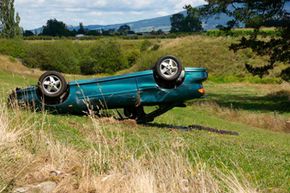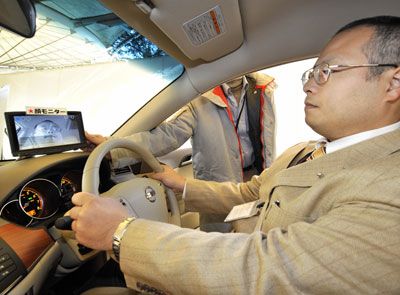Cars are getting safer all the time. With antilock brakes, automatic parking, backup cameras, airbags, radar collision detection -- you'd almost think nothing could go wrong while you're driving, assuming that you're a reasonably good driver and don't behave like an idiot behind the wheel. But what if something fails -- your brakes stop working or your car won't stop accelerating? Or you find yourself driving a little too riskily under unsafe conditions, like ice, snow or wet road surfaces? We have two words for you -- stolen from Douglas Adams' book, "The Hitchhiker's Guide to the Galaxy" -- don't panic!
If you know what to do, you can generally get your car safely back under control when it starts acting like it has a mind of its own. You just have to be prepared and keep a cool head. Here are some tips for how to handle an out-of-control car. We'll break them down into two basic categories: mechanical failures and bad road conditions.
Advertisement
First, the mechanical failures:
Brake failure: There's a traffic light ahead. Or a stopped car. Or you need to slow down for a turn. But when you put your foot on the brake pedal, nothing happens. This usually occurs because you've lost brake fluid or you've had too much wear and tear on your brake pads. Okay, you should have had these things checked out in advance, but knowing that doesn't help much when the brakes fail. What do you do?
Obviously, you shouldn't press the accelerator, but you figured that out yourself, right? If your brake pedal won't go down, check to make sure there's nothing blocking it, like a loose bottle that's rolled underneath. If so, just remove it. If the pedal goes down, try using the engine to brake. If you have a manual transmission, hit the clutch and drop to the next lower gear and then the next lower, though you might not want to drop all the way to first unless you absolutely have to. Most automatic transmissions will let you shift into lower gears too, but you won't need the clutch. If it's a real emergency and you're about to collide with something, you can drop more than one gear in a single downshift, but be warned that this may ruin your transmission. Still, it's a lot better than colliding with someone's rear bumper. Finally, you can use the emergency brake. (That's probably why they call it an emergency brake.) This doesn't work terribly well, as anybody who's accidentally started driving without taking the brake off can tell you, but it's better than nothing and can be used in conjunction with engine braking to reach a complete halt.
Runaway acceleration: Every now and then you hear about a car that takes off like a rocket sled even though nobody's increased the pressure on the accelerator. Usually this results in a manufacturer's recall, so it's probable you'll never have it happen to you. If it does, first check to make sure it isn't just a stuck accelerator pedal, where the pedal went down but became mechanically jammed and wouldn't come back up. In that case, wedge your right foot under the pedal to pull it back up and hit the brake with your left foot to slow back down. Even if the accelerator isn't stuck, put the car in neutral and apply firm, continuous pressure to the brake pedal to slow the car down. If for some reason this still doesn't work, turn the engine off. (In a Toyota with an engine button, this may require holding the button down for three seconds before it will respond.) If you have a key ignition, don't pull the key out. That would lock the steering wheel.
Advertisement


